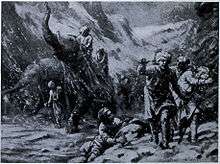Jayapala
Jayapala was a ruler of the Hindu Shahi dynasty from 964 to 1001 CE.
| Jayapala | |
|---|---|
| Parama Bhattaraka Maharajadhiraja | |
 Disaster of Jayapala Army due to snow fall | |
| Reign | 964 – 1001 CE |
| Predecessor | Mahajaraja Hutpal |
| Successor | Maharaja Anandapala |
| Dynasty | Hindu Shahi |
| Father | Hutpala |
| Religion | Hinduism |
His kingdom stretched from Laghman to Kashmir and Sirhind to Multan, with Peshawar being in the center.[1] He was the son of Maharaja Hutpal and the father of Maharaja Anandapala.[1] Epithets from the Bari Kot inscriptions record his full title as "Parama Bhattaraka Maharajadhiraja Sri Jayapaladeva".[2]
History
Maharaja Jayapala khatana is known successfully defending his kingdom against the Ghaznavids in the modern-day eastern Afghanistan and Pakistan region his entire life, until finally being defeated in Peshawar due to a snowstorm. Maharaja Jayapala saw a danger in the consolidation of the Ghaznavids and invaded their capital city of Ghazni both in the reign of Sebuktigin and in that of his son Mahmud, which initiated the Muslim Ghaznavid and Hindu Shahi struggles.[3] Jayapala, however, was defeated, and he was forced to pay an indemnity to Sebuktigin.[3] Maharaja Jayapala stopped paying tribute and took to the battlefield once more.[3] Maharaja Jayapala, however, lost the battle and control of the entire region between the Kabul Valley and Khyber Pass.[1]
Before his struggle began Maharaja Jayapala had raised a small army of Punjabis. When Jayapala went to the Punjab region, his army was raised of 10,000 horsemen and an smaller host of foot soldiers. According to Firishta:
The two armies having met on the confines of Lumghan, the Maharaja ascended a hill to view the forces of Sabuktigin, which appeared in extent like the boundless ocean, and in numbers like the ants or the locusts of the wilderness. However, Jayapala considered himself as a wolf about to attack a flock of sheep: calling, therefore, his chiefs together, he encouraged them to glory, and issued to each his commands. His soldiers, though few in number, were divided into squadrons of five hundred men each, which were directed to attack successively, one particular point of the Mooslim line, so that it might continually have to encounter fresh troops.[1]
However, the army was hopeless in battle against the eastern forces, particularly against the Punjabis.[1] In the year 1001, soon after Sultan Mahmud came to power and was occupied with the Qarakhanids north of the Hindu Kush, Maharaja Jayapala attacked Ghazni once more and upon suffered his first defeat by the powerful numerous Ghaznavid forces, near present-day Peshawar. After the Battle of Peshawar, Jayapala was captured, and although he was freed by a 50 elephant indemnity, he was ashamed since, as a member of the kshatriya caste, capture (or two defeats to a Muslim, depending on the source) meant a loss of caste. He abdicated in favor of his son and committed suicide by funeral pyre.[1][3][4][5]
Succession
Maharaja Jayapala was succeeded by his son Maharaja Anandapala,[3] who along with other succeeding generations of the Shahiya dynasty took part in various campaigns against the advancing Ghaznavids for decades successfully keeping them from crossing the Indus. [1]
References
- "Ameer Nasir-ood-Deen Subooktugeen". Ferishta, History of the Rise of Mohammedan Power in India, Volume 1: Section 15. Packard Humanities Institute. Archived from the original on 29 October 2013. Retrieved 30 December 2012.
- Sailendra Nath Sen. Ancient Indian History and Civilization. New Age International. p. 342. Retrieved 25 January 2014.
- P. M. Holt; Ann K. S. Lambton; Bernard Lewis, eds. (1977), The Cambridge history of Islam, Cambridge University Press, p. 3, ISBN 0-521-29137-2,
... Maharaja Jayapala of Waihind saw danger in the consolidation of the kingdom of Ghazna and decided to destroy it. He therefore invaded Ghazna many times, but was finally defeated...
- Keay, John (2000). India: A History. Great Britain: Harper Collins. p. 207. ISBN 978-0-8021-4558-1.
- Ferishta (trans. Dow, A.), The History of Hindoostan, vol.1, p.57